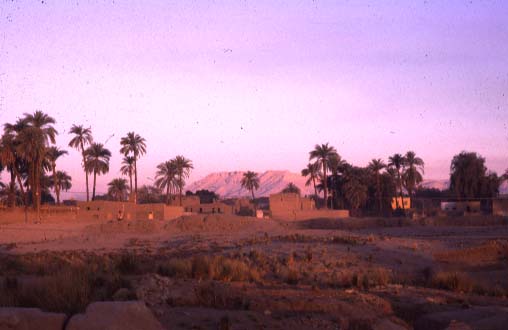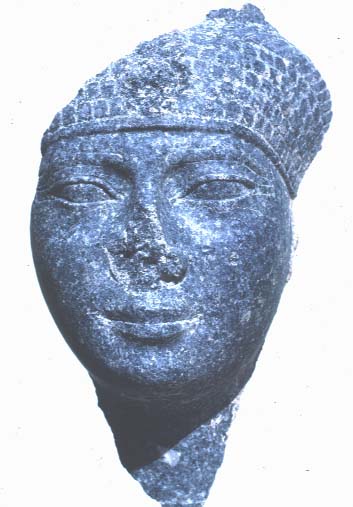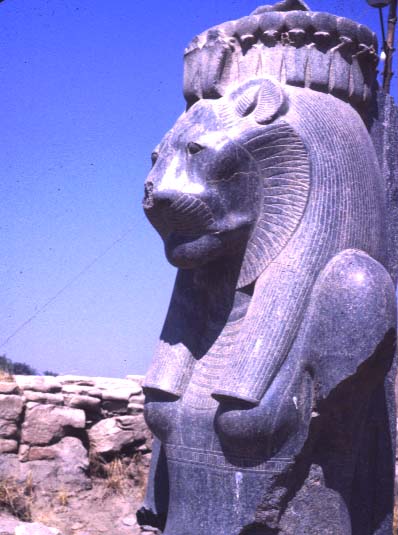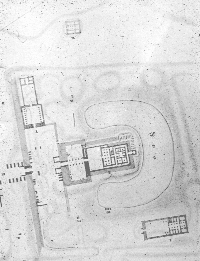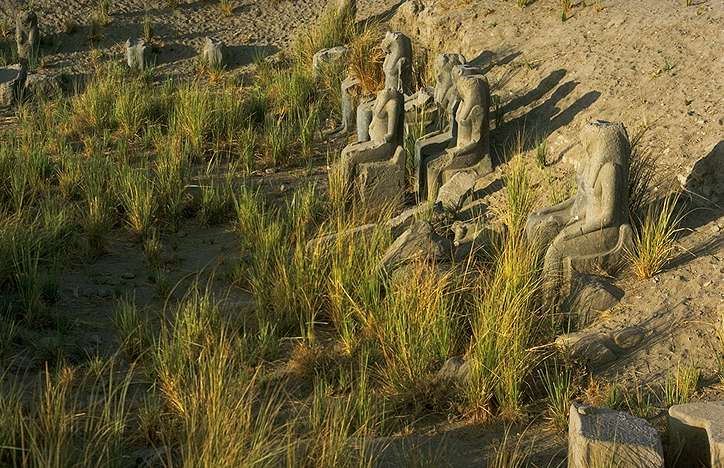The Precinct of The Goddess MutQueen of the GodsKarnak Temple Complex, Egypt |
The Goddess Mut
The goddess Mut was the wife of Amun, Egypt's imperial god, and the mother of the moon-god, Khonsu. In her human guise she was the heavenly regent of the kingship. In the form of lioness-headed Sakhmet ("The Powerful"), Mut was a fierce protector of Egypt and its kingship, bringing defeat and death to its enemies. She could threaten Egypt, too, if the proper rituals were not performed to ensure her contentment. The cults of Mut and goddesses associated with her, such as Hathor, Sakhmet, Bastet and Isis, became vital to Egyptian rule, and Mut's temple precinct was a major religious center for 2,000 years. Yet until recently the goddess and her cult were almost unknown and her precinct virtually unexplored.
This aerial view of the precinct includes the remains of three ruined temples with the temple of Mut at the center, as well as several subsiderary buildings and other structures. Perhaps the most impressive feature of the Precinct of Mut today is the wall of water-reeds growing around the rim of the sacred lake, the Isheru.
A HISTORY OF THE EXPLORATION OF THE MUT PRECINCT
One of the earliest plans of the Mut Precinct was produced
by the scholars of the Napoleonic Expedition of 1798-1801.(left)
Later 19th century explorers also visited the site and recorded their observations, including Nestor l'Hôte, whose 1839 reconstruction drawing includes details not present on other plans created earlier or later but which have now proved to be accurate. The Royal Prussian Expedition of 1842-1845 led by Karl Lepsius (map, right)
and the first directors of the Department of Antiquities of Egypt, August Mariette and Gaston Maspero, also recorded the site?s monuments.
From 1895 to 1897, two Englishwomen, Margaret Benson and Janet Gourlay, conducted the first serious archaeological work at the site, concentrating primarily on the Mut Temple proper. Despite their seeming amateur status, their work was as good as many excavators of their time.
For more on Margaret Benson and her three seasons
of excavation in the Temple of Mut click here.
No further work took place at the Precinct until the 1920s when Maurice Pillet, working for the Department of Antiquities of Egypt excavated Temple A, in the northeast corner of the site, and the Temple of Ramesses III (Temple C) west of the sacred lake. In the 1950s, French archaeologist Henri Chevrier, also working for the Department of Antiquities, carried out limited excavations within the Mut Temple, and in the 1970s Serge Sauneron, Director of the Centre franco-égyptien des Temples de Karnak, began work on the hieroglyphic texts of the Propylon, the site's main entrance. His work was cut short by his tragic death in 1976.
In 1976 the Egyptian Department of Antiquities granted permission to the Brooklyn Museum (now the Brooklyn Museum of Art) to begin a systematic exploration of the site and its monuments. The Detroit Institute of Arts has been associated with this ongoing archaeological project since 1978.The Staff of the current excavation.
THE MUT PRECINCT AND HOW IT GREW
The precinct of Mut lies about 100 yards south of the precinct of Amun to which it is oriented, and covers an area of about twenty acres. The focal point of the complex is the temple of Mut itself, surrounded on three sides by a lake called the Isheru, a term used to describe sacred lakes specific to precincts of goddesses who can be leonine in form. The Mut Precinct's Isheru, fed probably by an underground spring, is the largest in Egypt that is preserved.
The Precinct of the god Amun is on the left of the map (North).
The Precinct of Mut with the remains of its three temples is on the right (South).
Within the Precinct of Mut on this map Temple A is in the upper left corner, the Temple of Mut is in the center , and the Temple of Ramesses III is at the lower right.
The earliest datable temple structure is a part of the Mut Temple from the reigns of Queen-King Hatshepsut and her consort and successor, Tuthmosis III. The Mut expedition also uncovered a gate in an early western enclosure wall that bares traces of a possible graffito of Senenmut, an important official under Hatshepsut, and the cartouches of Tuthmosis III (perhaps replacing Hatshepsut?s cartouche), an Amarna period effacement of the name of Amun, and an inscription by Seti I recording the restoration of the gate.Despite the evidence of early Dynasty XVIII activity at the site, many publications continue to identify the Mut temple as a work of Amunhotep III, primarily because of the many statues of the goddess Sakhmet found at the site that bear his name.

However, it is now thought that the Sakhmet statues bearing the king?s name were originally erected in his funerary temple on the west bank of the Nile. They were probably brought to the Mut Precinct during Dynasty XIX when Mut and Sakhmet became more closely associated and rituals involving both with the Isheru first appear to have gained prominence. On the other hand, the Mut temple was expanded during later Dynasty XVIII, the Tuthmoside temple being enclosed by the new construction, and it is possible, although not certain that this expansion was one of Amunhotep III's many building projects.
During the New Kingdom, the precinct seems to have included only the Mut Temple and the sacred lake. The large temple to the northeast of the Mut Temple, called "Temple A" because its original name is unknown, was outside the Mut Precinct. First built during Dynasty XVIII, it was renovated and expanded by Ramesses II, who made the building a "temple of millions of years" dedicated to himself and to Amun-Re. He added a forecourt, a pylon, two colossal granite statues of himself and two colossal alabaster stelae. The first, recording his marriage to a Hittite princess, was uncovered by Maurice Pillet in the 1920s. The second was discovered by the Mut Expedition in 1979 and records Ramesses' work on a temple, most likely the temple before which the stela stood. In the Mut Temple itself, it was probably Ramesses II who added a stone facing to the south side of the temples' mud brick second pylon and new inscriptions and reliefs to the walls of the second court.
Later Ramesside kings also worked in the Mut Precinct and its environs. Ramesses III erected a temple to the west of the Isheru and outside the precinct's walls, a temple later incorporated into the precinct. This temple is on the same plan as Ramesses III's temple in the Amun precinct and bears on its outer walls the remains of the king's depictions of his Syrian and Libyan wars.
Under King Taharqa of the Kushite Dynasty XXV, the Mut Precinct grew dramatically, the work apparently directed by one of Taharka's most important officials, Montuemhat, Mayor of Thebes and Governor of Upper Egypt. Taharqa and Montuemhat rebuilt much of the Mut Temple, itself, using blocks from the earlier temples as building material for their expansion. Blocks of relief and inscriptions from Dynasty XVIII, XIX and XX temples are visible today in the foundations of Taharqa's temple. They also added two long columned porticoes to the north of the Mut Temple's first pylon that have parallels in the Kushite colonnades in the Amun precinct.
Reused column drum of Taharqa in the later Ptolemaic collonade.It was also in the reign of Taharqa that the Mut Precinct was expanded to include temple A. Which by Dynasty XXI have already become a mammisi, a temple celebrating the divine birth of a god (in this case Khonsu, son of Amun and Mut), and of the king himself. By this time, it appears that the temple of Ramesses III was no longer in use. Indeed, as the Mut Expedition has discovered, the second pylon of Temple A seems to have been constructed in part of stone quarried from Ramesses III's temple, including the feet, torsos and heads of colossal statues that once stood in the court of that temple. As part of the precinct's expansion and the new use of Temple A, Taharqa created a processional way leading from a gate in the newly built western wall of the precinct to Temple A. The remains of the gateway were discovered by the Mut Expedition in one of its first seasons of work.
While Taharqa was celebrated in relief and inscription, Montuemhat and his work did not go unrecorded. A small chapel dedicated to him was created in the eastern wall of the Mut temple has long been known, and in recent years, the Mut Expedition has uncovered remains of at least two other private chapels that relate to Montuemhat and to his son Nesptah. Indeed, there seems to have been a proliferation of small chapels in the precinct beginning in Dynasty XXV and continuing into Dynasty XXVI. One Dynasty XXVI chapel was dedicated to Nitocris, God's wife of Amun, and was built in the first court of Temple A.
It was probably during Dynasty XXX that the precinct achieved its present size and its distinctive trapezoidal shape. The site as it now exists includes not only the buildings described but also a large area to the south of the Isheru, Ramesses III's now-ruined temple, and the area north of it and west of the Taharqa gateway.
The Mut Precinct continued to prosper under the Ptolemies. Indeed, during the Ptolemaic Period the precinct was given a new main entrance gateway and significant parts of the Mut Temple and Temple A were rebuilt. Elsewhere, Ptolemies V and VII built a chapel (known as Chapel D), which was first excavated by the Mut Expedition, just inside the Taharqa gateway and dedicated to both Mut/Sakhmet and possibly to the Ptolemaic ancestor cult as well.
Even after the conquest of Egypt by Rome in 30 B.C., the Mut Precinct remained an important site. Two stelae record work at the site carried out under the auspices of the Emperors Augustus and Tiberius. In its exploration of the Mut Temple's walls, the Mut Expedition has uncovered the evidence of this restoration. It seems, however, that beginning in the first century A.D. the Mut Precinct began to decline. The Taharqa gateway was blocked off and a village grew up outside the gate but within the protection of the massive enclosure walls. By late Roman times the Mut Temple had ceased to function. The Mut Expedition has uncovered the remains of housing and work sites in the forecourt of Temple A and built up against the pylon of the Mut Temple itself near the ruins of the temple's porches.
PRESERVATION AND RESTORATION
One of the great tasks facing all archaeologists, in Egypt as elsewhere, is preserving and restoring the monuments uncovered - making them "live forever" as their creators intended - so that future generations may study and wonder at them. Like other sites, the Mut Precinct's monuments are threatened by rising groundwater levels and by the increasing salination of the soil in which the monuments sit. While it is impossible to protect buildings completely, conservation and restoration are two of the Mut Expedition's primary goals. Among the preservation projects have been the reconstruction of the Contra Temple, a small building abutting the Mut Temple; the conservation and re-erection of several Sakhmet statues uncovered by the expedition; the rebuilding of the inner face of the enclosure wall where it had collapsed on a row of sphinxes first restored by Maurice Pillet; and the partial rebuilding of the mud brick wing of the Mut Temple's second pylon to a height of nine feet. The expedition also continues to create safe outdoor storage for the many blocks of temple decoration that cannot be re-positioned in the walls but should be available for study by visitors.
If funding can be found, the Mut Expedition hopes in the future to be able to conserve and re-erect the colossal statues and stelae of Ramesses II that once stood before Temple A.
RECORDING AND EPIGRAPHIC WORK
Only by collating and translating the temple?s inscriptions and decorations, including those on the scattered blocks of temple decoration mentioned above, can we hope to understand how the cult and temple functioned and what they meant in their time. The Mut Expedition has assembled an international team of scholars from the United States, Holland and France to study and publish the religious texts, particularly those of the Ptolemaic Period (305-30 B.C.) which are the most extensive. Their publication will be of importance to the study of the goddess Mut and her cult, to the study of other major gods and goddesses and, indeed, to the study of Egyptian religion in general.
A final goal of the Mut Expedition is to produce accurate plans of the site's buildings to assist people in understanding their history and interactions. Existing plans created by earlier scholars have found to be rather inaccurate, in part because they were based on buildings that had not been fully excavated. The Mut Expedition is seeking to remedy this lack and has already produced a revised plan of the Mut Temple proper.
The work of the Brooklyn Museum's Mut Expedition, assisted by the Detroit Institute of Arts, has already made great contributions to the preservation and understanding of one of Egypt's major temple complexes and its resident goddess. Much, however, still remains to be done to make the Queen of the Gods and her temples accessible to scholars and visitors alike.
In 1976 the Brooklyn Museum essayed a survey and recording season and in 1977 started with the first season of digging which was concentrated in the northwest area of the precinct. In 1978 the Detroit Institute of Arts began its support of the work and participated until 2001.
A few views from the 2001 season Here.
For information on the 2005 season Here
